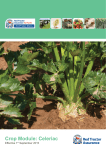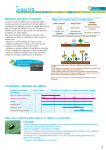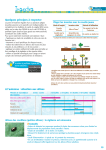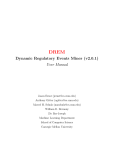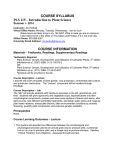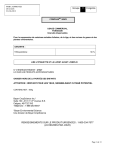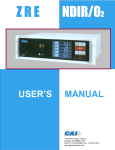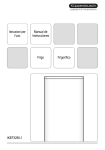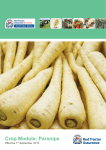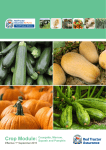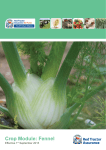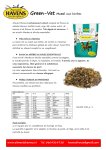Download Crop Module: Chicory - Red Tractor Assurance
Transcript
Crop Module: Chicory Effective 1st September 2015 Welcome T his crop specific module for chicory has been written to complement and avoid duplicating the generic principles of the Red Tractor Farm Assurance Fresh Produce Scheme standards. It is advisable to read the Red Tractor Farm Assurance Fresh Produce standards before reading this crop specific module. This module is designed to stimulate thought in the mind of the reader. It contains crop specific guidance and standards, where applicable, in addition to the requirements stated in the generic Fresh Produce standards. Within this module the important requirements outlined in the crop specific standards section will be verified during the Red Tractor Farm Assurance assessment and compliance will form a part of the certification/approval decision. Disclaimer and trade mark acknowledgement Although every effort has been made to ensure accuracy, Assured Food Standards does not accept any responsibility for errors and omissions. Trade names are only used in this module where use of that specific product is essential. All such products are annotated® and all trademark rights are hereby acknowledged. Notes: Pesticide Information General Introduction Following a systematic approach will help growers identify and manage the risks involved in crop production. This module is based on a typical crop production process and food safety, health & safety, environmental and quality hazards are identified. Appropriate controls may then be established to minimise risk. Food safety and health & safety issues always take precedent over quality and environmental controls. The layout of this module follows the same structure as that used in the Red Tractor Farm Assurance Fresh Produce Standards. The content of the module is reviewed prior to the issue of updated editions. The review process considers both new developments and all relevant technology which has emerged since the last review was completed and which have been found to be both workable by the grower and beneficial to the environment. The aim is to transfer such information and technologies to growers. Acknowledgements Red Tractor Farm Assurance Fresh Produce gratefully acknowledges the contribution of all consultees in the preparation of this protocol, particularly Brian Read of DGM Growers. The Red Tractor Fresh Produce team has been working with Fera to provide tailored access to the LIAISON database for all Red Tractor Fresh Produce members. This system allows individual growers access to all information for plant protection products approved for use under the Red Tractor Fresh Produce Scheme. LIAISON can be accessed under the Produce tab via the “Checkers and Services” page where you will also find a user manual. Searches will be filtered specifically for the crops for which you are registered. Once you have logged onto the site and clicked on the LIAISON hyperlink you will be directed to the LIAISON home screen. You will need a username and password and these will be sent once you have registered: http://assurance.redtractor.org.uk/rtassurance/ services/Registration/members.eb . Front cover image credit: DGM Growers. 1 Red Tractor Assurance for Farms – Crop-specific Module: Chicory © Assured Food Standards 2015 Content Contents ADDITIONAL REQUIREMENTS AGAINST CURRENT STANDARDS 02 CROP SPECIFIC STANDARDS02 CHOICE OF VARIETY OR ROOTSTOCK AND PLANT HEALTH CERTIFICATION 03 SITE AND SOIL MANAGEMENT 03 ENVIRONMENTAL PROTECTION AND CONTAMINATION CONTROL04 PEST, DISEASE AND WEED CONTROL 05 NUTRITION 08 HARVEST AND STORAGE 09 APPENDIX 1: MAJOR NUTRIENT REQUIREMENTS FOR CHICORY 10 ADDITIONAL REQUIREMENTS AGAINST CURRENT STANDARDS None for this crop module CROP SPECIFIC STANDARDS STANDARDS RECORDS (to be kept for 2 years) HOW YOU WILL BE MEASURED n PPP CQ.37.a application records If S-metolachlor is used it must be applied before the 31st May CQ.37.b n Trays High levels of hygiene and separation must be relied upon for minimising pest and disease problems in forced chicory n Basins CQ.37.c n Conductivity n Cleaning are washed thoroughly and all growing systems are cleaned with sodium hypochlorite solutions between forcing batches of chicory roots of around 1.4-2.0 is normal Where calcium nitrate and trace elements are added to the hydroponic solution electrical conductivity levels must be constantly monitored to minimise overdosing Red Tractor Assurance for Farms – Crop-specific Module: Chicory records n Electrical conductivity monitoring records © Assured Food Standards 2015 2 STANDARDS RECORDS (to be kept for 2 years) HOW YOU WILL BE MEASURED n pH CQ.37.d level monitoring records Where pH levels are being modified, levels must be constantly monitored n A table CQ.37.e Macro and micronutrient needs must be tested by assessing samples of soil or leaf tissue can be found in the chicory module that indicates which nutrients are best determined with a soil analysis and which are best determined by leaf tissue assessment n Soil/ leaf tissue testing records n Soil CQ.37.f nitrate testing records Soil nitrate sampling and testing must be undertaken CQ.37.g There must be adequate provision made for the removal of any free soil during storage CQ.37.h Temperatures must be reduced as quickly as possible in refrigerated stores and therefore adequate refrigeration capacity is needed CQ.37.i A system must be in place to maintain turgidity of the roots and minimise water loss n Initially n Store n This can include: – good insulation –low temperature differentials on the evaporators in cold store –adding humidification to the store by fogging or introducing water –drenching boxes – dipping roots in water tanks n Store the newly stored crop is respiring at a high rate so extreme caution is taken when entering sealed stores as oxygen levels may be seriously depleted temperature records temperature records GUIDANCE CHOICE OF VARIETY OR ROOTSTOCK AND PLANT HEALTH CERTIFICATION DEFINITIONS Chicory (Cichorium intybus var. sativum), also known by its Flemish name ‘witloof chicory’, is grown in the field for its swollen taproot. In the dark, under controlled conditions apical buds on the taproots develop into pointed ‘chicons’ (the process is known as ‘forcing’) which are eaten raw or cooked. Radicchio is a type of salad chicory grown for its red leaves. These, along with green leafed varieties such as Escarole and Frisee look like lettuces but have a characteristic bitter flavour. To add to the confusion, the French name for chicory is ‘endive’ and for endive ‘ chicoree frisee’. SITE AND SOIL MANAGEMENT SITE SITUATION Chicory is especially sensitive to any residue in the soil of a hormone herbicide. Such herbicides, including clopyralid, should be avoided in the previous crop. Particular care should be taken to minimise herbicide drift from neighbouring fields by careful siting and ensuring the neighbouring fields are treated in ideal conditions. Warm south-facing fields are preferred as the optimum temperature for chicory growth lies between 13°C and 24°C. Growth ceases if temperatures are below 7°C or above 30°C. A north-facing field should be avoided. Chicory will tolerate light frosts without damage, however, exposed sites with a history of late spring or early autumn frosts are best avoided. Witloof chicory belongs to the Compositae family, which also includes red and green leafed chicory, i.e. radicchio (Cichorium intybus var. foliosum), endive (Cichorium endivia) and lettuce (Lactuca sativa). 3 Red Tractor Assurance for Farms – Crop-specific Module: Chicory © Assured Food Standards 2015 ENVIRONMENTAL PROTECTION & CONTAMINATION CONTROL ROTATION Site diseases Certain soil-borne diseases will build up if chicory is cropped in a close rotation, namely: Downy mildew: Bremia lactucae (Regal) Watery soft rot: Sclerotinia minor (Jagger) Sclerotinia sclerotiorum (Lib.) de Bary Ringspot or Anthracnose: Bacterial Rots: Microdochium panattonianum (Berl.) Dickeya spp. (formally Erwinia spp). Pseudomonas spp. Xanthomonas spp. The soil-borne diseases that may attack chicory during forcing are: Phytophthora spp., Pythium spp., Dickeya dadantii (formally Erwinia chrysanthemi), Pseudomonas and Sclerotinia spp. All these soil-borne pathogens require host plants on which to multiply, in the absence of a host the pathogen population declines. Crop rotation, with several years between host crops, is a sustainable means of ensuring pathogen populations never build up significantly and decline in the intervening years. A minimum rotation of one in four years should be followed if the rotation is made up from crops not susceptible to Sclerotinia. If Sclerotinia susceptible crops are grown within the rotation, a one in six year rotation is essential provided the chicory follows a non-susceptible crop such as cereals. Cereals are the preferred crop to precede chicory. Site pests Many broad-leaved crops may host free-living nematodes of various species. If there has been a history of problems with establishment or poor crop performance caused by free-living nematodes, soil samples should be taken in the previous year. Selecting fields with minimal nematode populations is a useful cultural technique to avoid crop damage. Root stocks Root stocks must be sampled to determine maturity and order of forcing. The basic approach to crop protection Chicory is susceptible to a number of pest and disease problems but it is a guiding principle that pesticide inputs should be minimised through prevention rather than cure. An integrated approach should be adopted to achieve this by involving the following management steps: a. It is a useful principle to attempt to grow chicory crops in isolation as pest and disease infestations, if they do occur, are late and less prolific. b. Sensible crop rotation avoids the build-up of soilborne problems or disease carry- over from one crop to the next. Cultural preventative techniques a. Any crop waste left in the field should be ploughed in straight after harvesting to promote rapid breakdown by soil microbes. This prevents the debris acting as a source of inoculum to the remaining unharvested crop. b. Any crop waste (after storage and forcing periods) needs to be collected together before being taken to a designated dumping zone where it is preferably buried. Returning store crop waste to the source field is likely to result in the establishment of soil-borne diseases, and should be avoided. c. Crops enjoying good plant health through adequate nutrient supply are more tolerant to pest and disease attack. d. General plant health may also be assisted by reducing stresses, e.g. the judicious use of irrigation. Corrective action a. First establish the nature of any problem by receiving regular updates on monitoring and forecast services such as the Aphid Monitoring Service from the Home Grown Cereals Authority. These will provide information on any prevailing general threat. b. Monitor crops at regular intervals to detect the early presence of any pests or diseases. Care needs to be taken to correctly identify any potential pest or disease so that any corrective action is appropriate. c. Consider any prevailing factors which may mean the pest or disease becomes less significant, e.g. dry weather slows disease progress, but wet weather may reduce the threat from cutworm damage. Red Tractor Assurance for Farms – Crop-specific Module: Chicory © Assured Food Standards 2015 4 d. The timing of an agrochemical input can affect its efficacy. As a general rule applications early after infection or infestation are more effective than late applications, therefore, regular crop monitoring to detect early problems is essential. e. If chemical control is needed the following points should be considered: n use the least toxic and persistent product; n use the most selective product to reduce the impact on naturally occurring beneficial organisms; n use the minimum effective dose rate; n use appropriate application methods with properly maintained equipment (exceeding the dose is illegal under COPR). PEST, DISEASE AND WEED CONTROL PEST CONTROL Leaf miner There are no currently approved insecticides available for the control leaf miners (Liriomyza spp) in chicory. Peach-potato aphid Several aphid species attack chicory but only one, the peach-potato aphid (Myzus persicae), has shown resistance to insecticides. It is important to identify which aphid species is present to determine whether a resistance control strategy is appropriate. Aphid populations generally increase by the females reproducing without mating, under suitable conditions populations may increase very rapidly. As a general principle, good aphid control is obtained by early treatments so regular monitoring to detect aphids and predator presence allows timely treatments to be made. Predators are useful in controlling low aphid populations so care needs to be taken to decide if an insecticide is needed at all. If it is, a selective insecticide will not affect predators that should then control later infestations. The following guidelines indicate how an insecticide’s efficiency may be improved: i. In general medium sized droplets work well, but if weather conditions permit fine droplets are ideal as these provide better cover of the foliage and increase the probability of direct contact (the standard rate is 250l/ha of water) but heavy aphid infestations require increased water rates up to 500l/ha. Water rates below 250l/ha applied conventionally, increase the probability of poor control and need for re-application. 5 ii. Pyrethroid insecticides are prone to breakdown by ultra violet light so early evening applications are preferable as the aphids are likely to be mobile at night and so pick up insecticide more readily. iii. Anticholinesterase pesticides should not be mixed unless otherwise stated on their labels, for operator safety reasons. iv. Pirimicarb has both contact and vapour phase action, working best between 15°C and 25°C under still conditions. Its effectiveness is largely lost in windy conditions. v. If peach-potato aphids are present the following tables provide a guide to effective product types: Esterase resistance: S R1 R2 pyrethroids pirimicarb pirimicarb R3 pirimicarb Note: As resistance increases from S to R3 aphid colour changes from lime green to rosy pink. Lettuce root aphid Lettuce root aphid (LRA) can become a serious pest of chicory if the adults burrow into the soil and begin feeding on the roots. Several generations of LRA may be produced, causing sufficient root damage to result in plant stress from reduced water and nutrient uptake. The aphid over winters as eggs laid the previous autumn on lombardy or black poplar trees. In the spring the newly hatched immature aphids live in characteristic flask shaped galls on the leaf stalks. During the spring the young aphids develop into winged forms by June. The gall changes from green to orange/brown, dries and opens to release the winged adults to fly to a suitable host crop. Once they have reached a suitable host crop the time between landing on a leaf and burrowing down into the soil is very short - a few hours at the most. The control of LRA depends on the aphicide being present on plants before they arrive so the correct timing of aphicide requires monitoring of galls on poplar trees and noting the development of aphids within them. LRA can be particularly harmful in drought years, because the dry conditions exacerbate the stress induced by root damage. Red Tractor Assurance for Farms – Crop-specific Module: Chicory © Assured Food Standards 2015 Cutworm Cutworm is a general term given to the caterpillar larvae of the turnip moth. However, in some years the heart and dart moth, large yellow underwing moth and garden dart moth larvae may also cause cutworm-type problems. Risk of attack occurs under dry weather conditions on a range of broad-leaved crops, including chicory when grown on light soils. Adult moths emerge from May or early June until the end of July. Eggs are laid on the leaves of host plants the young caterpillars hatch 10 to 14 days later and begin feeding on the leaves. After three instars, the growing caterpillars drop to the soil surface and burrow into the soil to begin feeding on the roots and tap (storage) roots. Root feeding over June and July may cause serious damage to crops. Late attacks merely ‘graze’ the shoulder of the root and are not economically damaging. Through the winter the caterpillars remain underground, pupating between February and May, from which the adult form emerges. The control of cutworms depends on killing the leaf-feeding caterpillar stages. Control measures are ineffective once burrowing into the soil has occurred. Two main options for control are water droplets (i.e. rain/ irrigation) or insecticide application. Water, particularly as heavy droplets striking the crop leaves, ‘knocks’ young caterpillars to the soil surface, where they are unable to find leaves again and eventually die. A minimum of 12mm of heavy rain or 25mm of irrigation is effective at controlling cutworm larvae. Note: If irrigation is to be relied upon, even applications are required, as no control will be exerted in the underlaps. Pyrethroid insecticides are effective at killing young cutworm caterpillars on the leaf, and will need to be used if rainfall irrigation has not occurred in time. Effective cutworm control depends on the correct timing of control measures. Various cutworm warning services provide timely warnings for control based on daydegree accumulation to indicate cutworm development, coupled with rainfall/irrigation data. If rain/irrigation has not intervened and 3rd instar development has been reached, a recommendation to apply insecticide is given. The use of this service ensures the use of insecticides is minimised whilst seeking to achieve effective control. DISEASE CONTROL Sclerotinia Sclerotinia is an important disease of a wide range of broad-leaved crops, including chicory. Sclerotia are the survival organs and consist of a waterproof mass of tightly enmeshed hyphae. Sclerotia may survive for over 20 years in the soil, and will grow out to infect a suitable host crop when roots are in close vicinity. Susceptible crops include carrots, parsnips, brassicas (vegetables and oilseed rape), sugar beet, and beans. Some broad-leaved crops are less susceptible, but may still host Sclerotinia e.g. potatoes and linseed/flax. Monocotyledonous crops are not susceptible to Sclerotinia disease; this includes cereals (wheat, barley, triticale etc.), other graminaceous crops (maize and sweet corn) and the allium family (onions, garlic, chives and shallots). As sclerotia last for considerable periods of time in the soil, the key to long term cropping is to prevent this disease establishing from the outset. Sclerotinia-free land may be sustainably cropped with vegetables so long as break crops are used in the rotation. This has the effect of either maintaining or reducing inoculum at low levels. Sclerotinia may be particularly aggressive on chicory in store or in the forcing room where the high humidity and wet surfaces allows the pathogen to develop freely. Managing the storage conditions may helpful to limit disease expression, but it is most effective if inoculum from the field is minimal at harvest. The use of Sclerotinia-free land for chicory cropping is vital. Azoxystrobin will give some control of early field infection. Switch (Fludioxonil/Cyprodonil) is approved as a root drench at boxing for forcing, and is often necessary on all late stored roots. Contans is a fungal biological control of sclerotia in soil that is approved for use in all food crops and can reduce infection levels in the crop. Phytophthora Phytophthora spp. are common soil-borne fungi that generally affect chicory in storage, particularly during forcing. This fungus can be severe as inoculum may build up rapidly in hydroponic systems. A combination of pH control and calcium chloride additions provide partial control. Good cleaning of the hydroponic system and hygiene generally is critical to prevent spread of infection. Phytophthora transmission is greatest in water or wet conditions. Good field drainage is important. Chicory is often grown on ridges in Holland. Red Tractor Assurance for Farms – Crop-specific Module: Chicory © Assured Food Standards 2015 6 There is no control available for Sclerotinia and Botrytis beyond Azoxystrobin and Fludioxonil/Cyprodinil already mentioned. Phoma, Erwinia and Pseudomonas can occur but there are no products approved for their control. Botrytis Botrytis is a wide spread disease that can manifest itself in store. Nutrition WEED CONTROL Weed control in chicory is difficult. Three herbicides are approved in the UK. When applied pre-emergence in moist conditions, Propyzamide will give good control of many weeds. However, several common weeds are outside the spectrum controlled. Mayweeds, groundsel and small nettles are among the most troublesome and therefore site selection and previous cropping will be important. S-metolachlor is now approved in the UK but it must be applied before the 31st May. Chicory is frequently drilled in late May so a stale seed bed technique can aid weed control. Mechanical weed control in the crop is likely to be necessary. Forcing There are fewer products approved in the UK than elsewhere in Europe to protect chicory whilst it is being forced. Hence, high levels of hygiene and separation must be relied upon for minimising pest and disease problems. Good tray washing is essential. Basins and all growing systems must be cleaned with sodium hypochlorite solutions between forcing batches of chicory roots. Fruit flies and aphids There are no approvals available in the UK. Aphid control in the field is vital to stop carry over into the forcing rooms. Disease control is key in the forcing rooms to reduce potential feeding sites for fruit flies. Dry stick insect traps help to keep populations to acceptable low levels. 7 DISEASES Phoma Phoma generally is more problematic in store than in the field. The fungus survives in crop debris between susceptible host crops; thus limiting soil inoculum build up by ensuring good rotational intervals between chicory crops is essential. The expression of disease in store partly depends on the level of wounding at harvest so gentle handling helps reduce disease levels. Higher forcing temperatures early in the season can encourage bacterial diseases. Calcium nitrate and trace elements are added to the hydroponic solution. Electrical conductivity levels must be constantly monitored to minimise overdosing. Conductivity around 1.4-2.0 is normal. Where pH levels are also being modified, levels must be constantly monitored. Waste management Water from growing rooms and washings should be disposed of in a non-polluting fashion. APPROVED USES NOT INCLUDED ON THE PRODUCT LABEL In many circumstances, particularly for minor crops, product labels do not include all of the approved uses and growers wishing to check the approval notice of a particular product should note that this information is available using the LIAISON® search accessible via their RED TRACTOR Farm Assurance home page after logging in. A search on the ‘Specific Off-Label Approvals’ page of LIAISON® by crop or product name should yield a results page. A click on the product name should link to a summary of the approval information. Near the bottom of the summary is the specific off-label number (e.g. 0246/09) and this link will open up a pdf of the current SOLA document giving details of the extension of use. European Minor Use Approvals are replacing SOLAs. Red Tractor Assurance for Farms – Crop-specific Module: Chicory © Assured Food Standards 2015 NUTRITION Ensuring an adequate supply of nutrients allows crops to grow rapidly and result in high yields. Almost all plant nutrients are taken up as ions in the soil water supplied from soil reserves; therefore, careful management of soil fertility should aim to establish the correct soil nutrient conditions before planting. While monitoring crops during subsequent growth is helpful and allows remedial applications by foliar feeds or top dressing, the penalties incurred by early nutrient shortage are rarely recovered. NUTRIENT REQUIREMENT Nutrient Assessment The key factor dictating the availability of all nutrients is soil pH, monitoring and adjustment of pH is an essential first step towards good soil nutrient management. Macro and micronutrient needs must be tested by assessing samples of soil or leaf tissue. The following table indicates which nutrients are best determined with a soil analysis and which are best determined by leaf tissue assessment: Chicory will tolerate acid soil conditions (pH 5.0 to 6.8), although growth is better if pH lies between 6.0 and 6.8. Fields with a wide range of pH values can produce satisfactory crops if the cation exchange capacity (CEC) of the soil is above 10meq/g soil. The pH effects on crop performance are more likely to be critical on low CEC soils such as light sands. Soil analysis Leaf tissue Yes No Yes (separate testing) Yes Phosphate Yes Yes Potassium Yes Yes Magnesium Yes Yes Sulphur No Yes (N:S ratio) No (use pH + texture) Yes Copper Yes Not ideal Boron Yes Yes Micro nutrients Molybdenum Yes Yes Applications of micro nutrients should only be made after visible leaf deficiencies or tissue analysis justify their application. Soil pH Nitrogen Manganese Soil samples for nutrient analysis should be taken as 25 soil subsamples (an auger sample volume is adequate for each subsample) from an area not exceeding four hectares, each to plough layer depth (usually 15cm). Mineral nitrogen samples should be taken to 60 or 90cm depth. The subsamples should then be thoroughly mixed (the sample should weigh approx. 1kg) before sending to the laboratory. Major nutrients Any fertiliser applications need to be made on the basis of assessment by soil or leaf tissue samples, enabling the correct nutrient to be selected and dose rates appropriately adjusted. Examples of typical fertiliser recommendations are given in the Appendix which originate from ‘Fertiliser Manual RB209 (2010) 8th Edition’. It provides a sound base to guide fertiliser recommendations and applications, based on assessment of soil samples. Soil nitrate sampling must be undertaken and evidence held by the grower. Root analysis Nutrition should be geared to the root analysis described in the Appendix. Red Tractor Assurance for Farms – Crop-specific Module: Chicory © Assured Food Standards 2015 8 HARVEST AND STORAGE HARVESTING STORAGE Hygiene Loading stores It is advisable that precautions are taken to ensure that the chicory handled or stored is not contaminated by, damaged or exposed to anything that could affect its food quality. Storage can be either in bulk or in boxes. Box storage may be preferable especially in refrigerated stores where the crop is unloaded for forcing over a long period of time. There must be adequate provision made for the removal of any free soil. Time of harvest Harvest timing will depend on the market specification of the final root size that is usually between 3-6cm wide at the shoulder. Chicory crops can bulk up quickly in October so careful and regular monitoring is necessary. Rain before harvest can retard and setback maturity. Root analysis is practised in Europe and the technique is being developed in the UK. A potassium:calcium ratio of 8:1 or less is desirable. The dry matter level for late production should be more than 23%. Harvest Accurate topping is important, as any overtopped roots are effectively valueless. Accurate topping also minimises the amount of foliage in store. Mechanical handling can damage roots so care is needed to ensure damage is limited in all harvesting and handling operations. Early forced roots should be topped to 2.5cm. Late forced roots to 5cm. 9 Storage temperature Temperatures must be reduced as quickly as possible in refrigerated stores therefore adequate refrigeration capacity is needed. Initially the newly stored crop is respiring at a high rate so extreme caution must be taken when entering sealed stores as oxygen levels may be seriously depleted. Early crops of chicory require vernalization by a minimum period of chilled storage for 10 days at 5°C. Crops forced before Christmas can be stored at 0-1°C. After Christmas, the temperatures should be brought down to -2°C. The growing point of chicory freezes at minus 2.7 degrees centigrade. Everything must be done to maintain turgidity of the roots and minimise water loss. This includes good insulation, low temperature differentials on the evaporators in cold store, adding humidification to the store by fogging or introducing water, drenching boxes and also by dipping roots in water tanks. Red Tractor Assurance for Farms – Crop-specific Module: Chicory © Assured Food Standards 2015 APPENDIX 1: MAJOR NUTRIENT REQUIREMENTS (KG/HA) Correct nitrogen fertilisation is extremely important for good quality roots. Too high a level can adversely affect storage and subsequent forcing. Too low a level will affect root yield and also subsequent forcing. Even, steady growth of the roots is important for good forcing results and small applications of nitrogen fertilisers can be useful. Mineral N samples should be taken in March/April before sowing, again in early July in the growing crop. One approach is to top up soil mineral N to 75kg/Ha. Prior to sowing this can be done with granular fertilisers. In the growing crop small foliar applications of Urea can be used. (This should be applied on a dull day to minimise the risk of scorch). It is also important to consult the seed supplier, as some varieties are more tolerant of higher Nitrogen levels than others. N, P, K or Mg Index 0 1 2 3 4 4+ Nitrogen (N) 40 0 0 0 0 0 Phosphate (P2O5) 250 200 125 100 50 0 Nitrogen (N) 75 40 0 0 0 0 Phosphate (P2O5) 200 150 100 50 25 0 150 100 50 25 0 0 100 50 30 0 0 0 60 60 30 0 0 0 Fen Peats Other soils All soils Potassium (K2O) Sands/light soils Magnesium Other soils Magnesium Red Tractor Assurance for Farms – Crop-specific Module: Chicory © Assured Food Standards 2015 10 Nitrogen fertiliser adjustment Dutch work suggests that after harvest roots should be sampled and analysed for major nutrients. Target results should be in the following ranges for best forcing yields: Dry Matter 21-25% Nitrogen (early forcing) 700 - 1000mg/100gm DM (mid forcing) 1000 - 1100mg/100gm DM (late forcing) 1100 - 1300mg/100gm DM Phosphate 225 - 275mg/100gm DM Potassium 1500 - 2000mg/100gm DM Calcium 270 - 290mg/100gm DM Magnesium 125 - 150mg/100gm DM In addition, the K : Ca ratio should be less than 8:1 Representative field soil samples at 0 to 30cm and 30 to 60cm depths should be taken. It is important the bulked samples are frozen if they are not immediately sent for analysis as increased temperatures (and thereby increased bacterial activity) might lead to false readings. The analytical laboratory should provide a report sheet indicating the nitrogen available as nitrate and ammonium in ppm. Most report sheets also provide a conversion of ppm into available nitrogen as kg N/ha. In case no such conversion is provided, the following guide may be used: For each soil horizon, add together the nitrate and ammonium ppm values to give total available nitrogen in ppm for that horizon. Add together the values for both horizons to arrive at a total nitrogen ppm for the rooting zone (i.e. 0 to 60cm). Multiply the total available nitrogen ppm value by one of the following factors to result in kg available N/ha. Dry sand Dry peat Moist sand Dry loam Dry clay, Dry silt Moist loam, Moist peat Moist clay Moist silt 1.0 1.1 1.2 1.4 This table assumes a soil bulk density of 1.4, if the actual soil bulk density is markedly different from this multiply the total available nitrogen ppm value by the known bulk density then divide by 1.4. To calculate the nitrogen fertiliser requirement in kg N/ha deduct the “N min” value from the desired level. Notes: Only 40kg N/ha should be applied as a maximum base dressing before sowing, the balance is then applied after crop establishment when the crop is growing strongly, no nitrogen dressings should be made after the 15 August. The nitrogen calculation equation for chicory has been arrived at by adding the usual Dutch nitrogen application (i.e. 70kg N/ha) to the average available soil nitrogen in Holland (i.e. 60kg N/ha) to give an estimated 130kg N/ha total requirement. This means that nitrogen fertiliser applications can be reduced if soil available nitrogen is plentiful, or increased if it is meagre. 11 Red Tractor Assurance for Farms – Crop-specific Module: Chicory © Assured Food Standards 2015 NOTES Red Tractor Assurance for Farms – Crop-specific Module: Chicory © Assured Food Standards 2015 12 NOTES 13 Red Tractor Assurance for Farms – Crop-specific Module: Chicory © Assured Food Standards 2015 Certification Bodies Your routine point of contact with the Scheme is through your Certification Body. Certification Bodies are licensed by Red Tractor to manage membership applications and to carry out assessment and certification against the Standards. The table below shows which Certification Bodies apply to each enterprise. Certification Body NSF Kiwa PAI SAI Global SFQC Beef and Lamb Dairy Combinable Crops and Sugar Beet Fresh Produce 4 4 4 4 4 4 4 4 4 4 4 4 4 4 4 4 NIFCC (Northern Ireland) 4 QWFC (Wales) 4 Pigs Poultry 4 4 4 4 4 4 4 NSF Certification Kiwa PAI Hanborough Business Park Long Hanborough Oxford OX29 8SJ Tel: 01993 885739 Email: [email protected] Web: www.nsf-foodeurope.com The Inspire, Hornbeam Square West, Harrogate, North Yorkshire HG2 8PA Tel: 01423 878878 Email: [email protected] Web: www.kiwa.co.uk/pai SAI Global Assurance Services Ltd PO Box 6236, Milton Keynes MK1 9ES Tel: 01908 249973 Email: [email protected] Web: www.saiglobal.com/assurance QWFC SFQC Ltd NIFCC [Northern Ireland] QWFC [Wales] Royal Highland Centre, 10th Avenue, Ingliston, Edinburgh EH28 8NF Tel: 0131 335 6605 Email: [email protected] Web: www.sfqc.co.uk Lissue House, 31 Ballinderry Rd, Lisburn, Northern Ireland BT28 2SL Tel: 028 9263 3017 Email: [email protected] Web: www.nifcc.co.uk PO Box 8, Gorseland, North Road Aberystwyth SY23 2WB Tel: 01970 636688 Email: [email protected] Web: www.wlbp.co.uk T: 01932 589 800 E: [email protected] www.redtractorassurance.org.uk Fresh Produce Standards



















